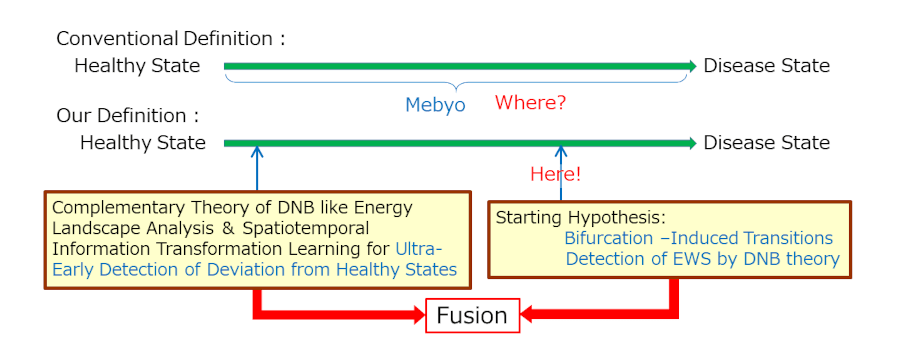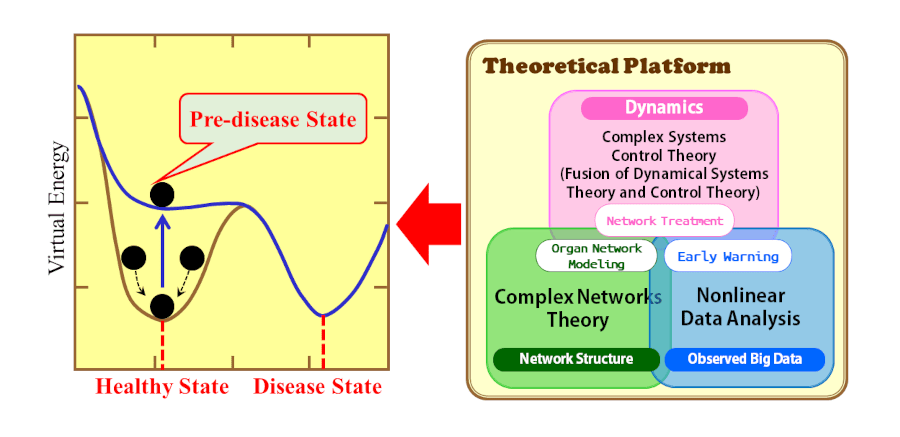R&D Project

Goal 2 R&D Projects (Selected in 2020)Comprehensive Mathematical Understanding of the Complex Control System between Organs and Challenge for Ultra-Early Precision Medicine
Project manager (PM)AIHARA KazuyukiUniversity Professor / Professor Emeritus, The University of Tokyo
Summary of the project
We will establish integrated research between mathematical studies with mathematical data analysis and modeling analysis, and experimental studies on physiological interaction and control between organs. In particular, we develop DNB (Dynamical Network Biomarkers) theory and its complementary theory & AI like spatiotemporal information transforming learning to detect the pre-disease states (Mebyo) and deviation from healthy states, respectively, at ultra-early timing before tipping points to disease states and propose methodology for Ultra-Early Medicine based on such ultra-early detection as well as treatments with control theory on physiological networks. The long-term purpose of this project is to realize a society equipped with ultra-early disease prediction and intervention systems by 2050.

Milestone by year 2030
Based on mathematical & AI studies, we will develop methodology of network medicine to detect early warning signals of diseases in the pre-disease states before diseases will really occur and to cure imminent diseases before the onsets by network control.
Milestone by year 2025
We will develop methodology for detecting early warning signals of diseases in pre-disease states before the onsets by analyzing various biological and medical data on the basis of mathematical data analysis and mathematical modeling analysis.

R&D theme progress reports
Performers
| Theme [1] | AIHARA Kazuyuki | The University of Tokyo |
|---|---|---|
| Theme [1] | KIMURA Takahiro | The Jikei University School of Medicine |
| Theme [1] | MINAMINO Tetsuo | Kagawa University |
| Theme [1] | FUJIU Katsuhito | The University of Tokyo |
| Theme [1] | AWAZU Akinori | Hiroshima University |
| Theme [1] | MORINO Kai | Kyushu University |
| Theme [1] | OKAMOTO Yuji | Kyoto University |
| Theme [1] | MASUDA Naoki | State University of New York at Buffalo |
| Theme [1] | IMURA Jun-ichi | Institute of Science Tokyo |
| Theme [1] | IWAMI Shingo | Nagoya University |
| Theme [1] | OKADA Yukinori | The University of Osaka |
| Theme [2] | SAITO Shigeru | University of Toyama |
| Theme [2] | HAYASHI Shusaku | Kyoto Pharmaceutical University |
| Theme [2] | KASAI Kiyoto | The University of Tokyo |
| Theme [3] | FUJIWARA Kantaro | The University of Tokyo |
| Theme [3] | IIDA Keita | The University of Osaka |
| Theme [3] | NOSHITA Koji | Kyushu University |
| Theme [3] | YAMAJI Kazutsuna | National Institute of Informatics |
| Theme [3] | SUZUKI Hideyuki | The University of Osaka |
| Theme [3] | TANAKA Gouhei | Nagoya Institute of Technology |
| Theme [3] | KAJI Shizuo | Kyoto University |
| Theme [3] | TAKEUCHI Tomoya | Chiba Institute of Technology |
| Theme [3] | SVIRIDOVA Nina | Tokyo City University |
| Theme [3] | HIRAOKA Yasuaki | Kyoto University |
| Theme [3] | TAMADA Yoshinori | Hirosaki University |
| Theme [3] | IIJIMA Yoshihiko | Fujita Health University |
| Theme [3] | ISOBE Tetsu | Keio University |
| Theme [3] | YOSHIDA Masayuki | Institute of Science Tokyo |
| Theme [3] | KAMISATO Ayako | National Center for Child Health and Development |
PDF Download
- Summary of the project (427KB)